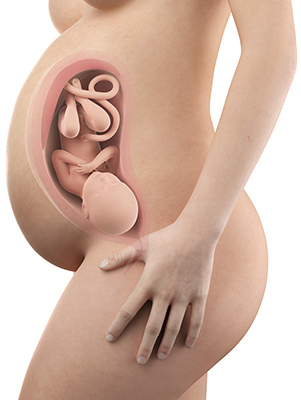You’ve made it to 35 weeks—what an incredible journey you’re on! With just about a month until you meet your little one, this week is full of change, anticipation, and a little bit of wonder. Your baby is almost ready to greet the world, and your body is working hard to finish the final touches. It’s normal to feel a mix of excitement and nerves as you get closer to delivery, but remember, you are doing amazingly well and you’re never alone on this path.
By now, your baby is getting chubbier and adding a little more fat to prepare for life outside the womb. Their immune system is getting stronger, thanks to the antibodies you’re providing. Right now, your baby is about the size of a honeydew melon and weighs nearly 5½ pounds (2.5 kilograms). They might be snuggled lower in your belly as they get into position for birth, which for many moms relieves the pressure on their lungs, but may make new pressure on the bladder or hips.

As for you, your body might be sending stronger signals that the big day is coming. It’s common at this point to notice more Braxton Hicks contractions, which are your body’s way of practicing for labor. You may see more swelling in your feet or hands, possibly feel warmer than usual, or need more breaks to catch your breath. It’s absolutely okay to slow down—let loved ones help and listen to your body’s requests for rest.
Now is a great time to double-check your hospital bag, finalize your birth plan, and talk through any last-minute questions with your doctor or midwife. Some mothers find comfort in arranging care for pets or older children, setting up the baby’s crib, or even stocking the freezer with easy meals for those first couple of weeks after birth.
This week is about looking forward, finishing up preparations, and giving yourself the patience and kindness you deserve. Even if you’re feeling tired, remember that each day brings you closer to holding your baby in your arms. You’re in the home stretch—take a deep breath and know you’re ready for what’s ahead.
Your Baby’s Development This Week
Congratulations—you’re 35 weeks along! With just about a month to go, your baby is entering the final stages of development, getting ready to meet the world. Let’s take a closer look at what’s happening inside your belly this week and how these changes help prepare your little one for a healthy start.
Right now, your baby is about as long as a bunch of Swiss chard—measuring 20 to 21 inches from head to toe! They’re also weighing in at around 5.5 to 6.5 pounds. Each week, your little one gets plumper, adding about half a pound or more, mostly in the form of fat stores that’ll help them stay cozy and warm outside the womb. You may notice your belly feels heavier, and every wiggle or stretch seems a little stronger—that’s your baby getting stronger, too!
One big development at 35 weeks is your baby’s skin. Earlier in pregnancy, the skin was thin and a bit see-through. Now, thanks to all that new fat, your baby’s skin looks pinker, smoother, and less wrinkled. There’s also a creamy, white coating called vernix that’s thickening on their skin. This special layer acts like a gentle moisturizer, protecting your baby’s skin in the watery world of your uterus right until birth.
Your baby’s lungs are also almost completely ready for breathing air. They’re now making more surfactant, a vital substance that keeps the air sacs in their lungs open after those first big breaths. Even though the lungs are very close to full maturity, the last few weeks are still important. This is why doctors often encourage babies to stay put until full term if possible.
Inside your little one’s head, the brain is ramping up development. In fact, during this stage, their brain growth is faster than at any other time in pregnancy. The brain is responsible for new skills—like blinking, closing their eyes during sleep, and responding to bright lights and sounds. These new connections help prepare your baby for all the exciting experiences that lie ahead.
Most of the soft, downy hair (called lanugo) that once covered your baby’s skin has now vanished, though a few patches may linger on the shoulders or back at birth. Hair on the head continues to fill in, and fingernails are now long enough to reach tiny fingertips.
By now, many babies have settled into a head-down position with their head resting against your pelvis. This position is ideal for delivery and means your baby is getting ready for the big day. You may notice more pronounced kicks or stretches at your ribs as your baby finds the comfiest spot to wait for labor.
- Fun fact: At this point, your baby’s hearing is well developed. They can recognize your voice and may even respond to soothing music or Dad’s talking!
- If you feel fewer movements or notice any changes in your baby’s activity, let your provider know right away—keeping track of kicks is still very important in these last weeks.
Every week brings new milestones, and your baby’s development is right on track for the exciting journey ahead. Enjoy these last precious weeks of pregnancy as your baby grows stronger and more ready for life outside!
Changes in the Mother’s Body
At 35 weeks pregnant, your body is getting ready for the final stretch before meeting your baby. While you’ve already felt many changes throughout your pregnancy, this week often brings some new sensations and signs as your body prepares for labor and delivery. Here’s what you might experience, and some tips for taking good care of yourself during this important time.
1. Baby Begins to “Drop”
One of the most noticeable changes for many women at 35 weeks is a feeling that the baby is settling lower in your belly—a process called “lightening” or “engagement.” If your little one moves downward, you may start to feel less pressure on your lungs, making it easier to catch your breath when walking or climbing stairs. However, with your baby pressing more on your bladder and pelvis, you might find yourself needing the bathroom more often or noticing increased heaviness or pressure down low.
2. Shifts in Your Belly and Posture
Your belly is likely at its largest right now, often stretching about 6 inches above your belly button. This can affect your balance, making it a little trickier to move around quickly or bend over. Some women notice their walk changes or they have to move more thoughtfully. It’s helpful to wear supportive shoes and take your time when standing up from a chair or getting out of bed.
3. An Increase in Aches and Twinges
You might feel soreness in your hips, lower back, or even shooting pains down your legs. This happens because the extra weight and relaxation of your joints are designed to help your body prepare for labor. Don’t be surprised if you feel tingling or numbness in your hands or feet, as swelling can sometimes press on nerves. For relief, try gentle stretching, warm baths, or short, slow walks.
4. More Frequent Fatigue—With Surprising Energy Bursts
It’s normal to feel more tired, as your body works harder than ever to support your growing baby. You may notice you get winded more easily, or need more rests during the day. Many women also experience something known as the “nesting instinct”—sudden bursts of energy that drive you to clean, organize, or prepare for the baby’s arrival. Listen to your body: when you’re feeling energetic, enjoy the motivation, but always remember to rest as much as you need.
5. Physical Signs to Watch For
- Pelvic pressure: More fullness or heaviness in your lower abdomen as your baby settles deeper.
- Vaginal discharge: You may notice more fluid, or even your mucus plug coming out—a normal part of getting ready for labor.
- Mild swelling: Slight puffiness in your ankles, hands, or face is common, but always tell your provider right away if swelling is sudden or severe.
- Practice contractions: Braxton Hicks contractions can feel like your belly is tightening for a minute and then relaxing, preparing your body for the real thing later on.
Remember, every woman’s pregnancy is a little different. If you’re unsure about a symptom, or if something feels alarming (like severe pain, headache, vision changes, or reduced baby movement), it’s always best to reach out to your healthcare provider.
During this time, accepting help from loved ones, prioritizing rest, and listening to your body can make these last weeks more comfortable. Hang in there—you’re doing a wonderful job, and soon you’ll get to meet your little one!
Medical Checkups and Screening at Week 35: What to Expect
As you enter week 35 of your pregnancy, you’re in the home stretch! This is a key time to check in on both your health and your baby’s well-being. Your doctor or midwife will usually start seeing you more often—often every week—so you both feel confident and ready for your baby’s arrival.
- Group B Strep Test: At around 35 to 37 weeks, you will likely have a quick test for something called Group B Streptococcus (often just called “Group B Strep” or GBS). This test checks for a common type of bacteria that some women carry. It isn’t harmful to you, but your baby could get sick during birth if you carry it. The test is simple—it just involves swabbing the vaginal and rectal areas for a sample, usually done right in your provider’s office. If you do carry GBS, you’ll get antibiotics during labor to protect your baby. No prepping is needed, and results usually come back in a few days.
- Vital Signs and Measurements: Every visit, your provider will check your blood pressure and weight. They’ll also listen to your baby’s heartbeat and may gently feel your belly to see how your little one is positioned. Sometimes, measuring your belly helps track your baby’s growth.
- Checking Baby’s Position: By this stage, most babies have settled into a “head-down” position, which is best for birth. Your doctor or midwife will gently feel your abdomen to check this. If your baby isn’t head-down, don’t worry—there’s still a little time for movement, and your provider might discuss gentle ways to encourage your baby to turn if needed.
- Talking About Signs of Labor: At this point, your healthcare provider will start discussing what to expect as your body gets ready for birth. This includes going over things like contractions, your water breaking, and when you should call or come in. It’s a great time to ask any questions about what exactly to watch for or when you should head to the hospital or birthing center.
- Reviewing Symptoms and Comfort: Your doctor or nurse will want to hear about how you’re truly feeling, from aches and pains to worries and everyday symptoms. If you’re dealing with swelling, headaches, blurry vision, or any sudden changes, bring these up—they could be important signs your provider needs to know about.
- Monitoring Baby’s Movements: How much your baby is moving is a good sign of their well-being. Your provider may ask if you’re still noticing regular kicks, stretches, and wiggles. If you notice a big drop in movement, reach out sooner rather than later. There are also simple “kick count” methods you can use at home to reassure yourself.
Finally, these frequent visits are a safe space: share all your questions and anything that’s on your mind, no matter how small it seems. Every pregnancy and baby is unique, so your doctor or midwife is there to support you, help you prepare, and make sure you and your baby are healthy as you approach delivery.
Nutritional Tips and Physical Exercise
At 35 weeks pregnant, you’re getting so close to meeting your baby! Taking good care of yourself is more important than ever. Here are some tips on eating well and moving your body as you enter these final weeks:
- Choose Colorful Foods: Bright fruits and vegetables—like carrots, berries, spinach, and sweet potatoes—are full of vitamins and support your baby’s ongoing development. Try to have several different colors on your plate each day for a mix of nutrients.
- Look for Small, Frequent Meals: Your growing belly can make it hard to eat big meals. Having smaller snacks throughout the day can help keep your energy up and ease heartburn or nausea.
- Add Healthy Fats: Healthy fats found in avocado, olive oil, nuts, and seeds help your baby’s brain keep growing. A handful of walnuts, a drizzle of olive oil on salads, or a slice of whole-grain toast with nut butter are all simple ways to include these in your diet.
- Stay Ahead on Iron and Calcium: Your body uses more of these minerals in late pregnancy. Add beans, lentils, leafy greens, eggs, yogurt, or fortified cereals for a boost. You could pair vitamin C-rich foods (like oranges or bell peppers) with iron-rich meals to help your body absorb the iron better.
- Don’t Skip Hydration: As your body gets ready for labor, water helps transport nutrients to your baby and prevents swelling or headaches. Keep a water bottle close by and take small sips all day. Herbal teas or water with lemon can make hydration a bit more fun.
- Limit Processed Foods and Sugar: It’s tempting to reach for sweets when energy dips, but try to choose wholesome snacks—like apple slices with nut butter, plain yogurt with berries, or whole-grain crackers with cheese.
Safe Physical Exercise
- Keep It Gentle: Your body may feel heavier and more tired now, so choose low-impact activities like walking, swimming, or gentle prenatal yoga. These can relieve back aches, reduce swelling, and improve your mood without overexertion.
- Practice Breathing and Relaxation: Learning deep, slow breathing isn’t just calming—it can help during labor too. Take a few minutes each day to sit quietly, breathe deeply, and focus on relaxing your muscles.
- Pelvic Floor Exercises (Kegels): Strengthening your pelvic floor muscles can help prevent leaking when you cough or sneeze, and may help with recovery after birth. To do a Kegel, squeeze as if you’re stopping the flow of urine, hold for a few seconds, and release.
- Listen To Your Body: It’s normal if you need more rest now. Stop and rest if you feel dizzy, short of breath, or notice contractions. Gentle stretching or simply changing positions can offer relief as well.
- Include Your Partner or a Friend: Invite a loved one on walks or to join you in a gentle stretch session. Together time can lift your spirits and help you feel more supported as you get ready for baby’s arrival.
Remember, every mom is different—what feels great to one person might be too much for another. If you have questions about nutrition or exercise, don’t hesitate to ask your healthcare provider. You are doing a wonderful job taking care of yourself and your little one!
Weekly Checklist
Here’s your caring guide for Week 35—helping you feel prepared, supported, and empowered as you near the finish line. Each item is meant to make you and your baby as comfortable and healthy as possible in this final stretch.
- Pack Your Hospital Bag: Gather essentials like comfy clothes, toiletries, snacks, your birth plan (if you have one), and important documents. Don’t forget a going-home outfit for your baby and something cozy for yourself.
- Finalize Your Birth Plan: Discuss your preferences and any concerns with your provider, but stay flexible—birth can be unpredictable, and your care team will help guide you.
- Prepare for Group B Strep Test: Your provider may perform a quick, simple swab between now and next week. If you have questions, ask what to expect and why this test is important for your baby’s health.
- Install and Check Your Car Seat: Review installation instructions or visit a local inspection center—many hospitals or fire departments offer free checks to ensure your baby’s car seat is safely in place.
- Keep Up with Baby Movements: Continue paying attention to your baby’s kicks, rolls, and stretches. If you notice a significant decrease in activity, call your provider right away—it’s always better to be cautious.
- Prioritize Rest and Sleep: Try to nap during the day if nighttime sleep is difficult. A body pillow or extra cushions can make resting more comfortable as your body changes.
- Stock Your Pantry and Freezer: Prepare and freeze some simple, nourishing meals you can reheat after your baby arrives. Ask loved ones for help with grocery runs if you’re feeling tired.
- Practice Relaxation Techniques: Deep breathing, gentle stretching, or even five quiet minutes with your feet up can ease muscle tension and stress. These habits support both you and your baby.
- Stay Connected: Talk with your partner or loved ones about how you’re feeling emotionally. Ask for support and be honest about your needs—caring for yourself is vital.
- Stay Hydrated and Nourished: Remember to sip water often and keep up with healthy snacks, like yogurt, fruit, or whole grain toast. Your body needs extra fuel and fluids in these final weeks.
- Ask About Any New Symptoms: Swelling, headaches, or vision changes should always be discussed with your healthcare provider to rule out any concerns like preeclampsia.
- Be Gentle With Yourself: Trust your instincts and celebrate how far you’ve come. You’re almost there—each day gets you closer to meeting your baby!
When to Call Your Provider
As you reach Week 35, your body is working hard to prepare for your baby’s arrival. Most pregnancy changes are perfectly normal, but sometimes a symptom could be a sign that you or your baby need extra care. Knowing when to reach out can make all the difference for your peace of mind and your baby’s health.
- Sudden or constant pain: If you feel strong, persistent pain in your belly, lower back, or pelvis that doesn’t improve, it’s important to get it checked.
- Bleeding or unusual discharge: If you notice bright red blood, a sudden gush, or increase in watery fluid from your vagina—even if it’s painless—it could be your water breaking or another concern. Reach out right away.
- Severe headache or vision changes: Intense headaches that don’t go away, along with blurry vision, seeing spots, or sensitivity to light, can be warning signs of high blood pressure.
- High fever: If your temperature goes above 100.4°F (38°C) and you have chills or feel unwell, let your healthcare provider know.
- Decreased baby movements: If your baby seems less active than usual or if you’re noticing fewer kicks or wiggles, try a glass of cold water, rest on your side, and pay attention. If things still feel quiet, call for guidance.
- Strong pressure or cramps: Regular tightening or cramping, more than four in an hour, could be the start of labor—even if it feels early. Don’t hesitate to call for advice.
- Swelling in face or hands: A bit of swelling in your feet or ankles can be normal, but sudden puffiness in your face, hands, or around your eyes needs prompt attention.
- Difficulty breathing or chest pain: If it suddenly becomes hard to catch your breath, you’re struggling with chest discomfort, or your heart feels like it’s racing or pounding, call immediately.
- Signs of infection: If you have pain, burning when you pee, foul-smelling discharge, or feel generally unwell, your provider will want to know.
- Severe itching: Ongoing, intense itching—especially on your hands and feet—can sometimes point to a liver condition that needs evaluation.
Remember, you know your body best. If something just “doesn’t feel right” or you’re worried—even if it’s not on this list—trust your instincts and reach out. It’s always better to check in and be reassured. Your care team is here to help you and your baby stay healthy and safe.
Preparations for Baby
As week 35 arrives, you’re in the home stretch! It’s normal to feel a mix of excitement and nerves as you get ready to welcome your little one. This is a great time to focus on both emotional preparations and making sure your home is ready for baby’s arrival. Setting up now can help you feel more calm and confident for the big day.
- Practice Self-Kindness: It’s natural to have ups and downs emotionally. Try sharing your feelings with your partner or a close friend—sometimes just talking things through is a huge relief. If you feel worried or unsure, remember you’re not alone and it’s always okay to reach out for help.
- Arrange a Help Network: Consider asking family or friends if they can help out in the early days, even with simple things like dropping off meals, walking the dog, or running errands. Having a short list of people you can lean on brings peace of mind.
- Set Up the Sleeping Area: Make up the crib or bassinet with fresh sheets, and keep extra blankets and clothes within easy reach for nighttime changes.
- Prep for Feeding: For breastfeeding, gather supplies like nursing bras, breast pads, or a pillow for support. If bottle-feeding, wash bottles and sterilize them so they’re ready to go.
- Organize Baby Essentials: Stock a basket or drawer with diapers, wipes, and a change of clothes for quick access. This is handy for late-night changes when you’re tired.
- Pack Your Hospital Bag: Include comfortable clothes, snacks, baby outfits, basic toiletries, and anything else that will help you feel at ease during your stay.
- Install the Car Seat: Make sure it’s properly secured in your car. If you’re unsure, many fire stations and hospitals offer free checks for car seat safety.
- Take Small Breaks to Connect: Spend quiet moments with your partner or loved ones—maybe a special meal together or a simple walk. These memories can be a comforting anchor as you become a new parent.
- Review Your Birth Plan: If you haven’t already, discuss your wishes and any questions you have about labor or delivery with your provider. Being informed can help you feel more in control and at ease.
- Set Up a Relaxing Space: Keep a corner ready for you to rest, with cozy blankets, water, and a book or music. Resting now is just as important as getting everything ready!
Above all, remind yourself that you’re doing a wonderful job. No home is ever perfectly prepared, but your love and care are exactly what your baby needs most. Trust your instincts and take things one step at a time—you’re almost there!
Citations and References
- American College of Obstetricians and Gynecologists (ACOG) – Details normal fetal development, recommended prenatal visits, Group B Strep screening, nutrition, and preparing for labor in the third trimester. Visit Source
- Centers for Disease Control and Prevention (CDC) – Provides guidelines on Group B Streptococcus (GBS) screening and prevention during late pregnancy. Visit Source
- Mayo Clinic – Offers comprehensive week-by-week fetal growth milestones and common maternal symptoms, along with prenatal nutrition and health advice. Visit Source
- Cleveland Clinic – Discusses physical changes, fetal growth metrics, and what to expect in the final weeks of pregnancy. Visit Source
- National Institutes of Health (NIH) – MedlinePlus – Recommends on optimal prenatal nutrition and outlines key nutrients needed during pregnancy. Visit Source
- World Health Organization (WHO) – Sets global standards for antenatal care, nutrition during pregnancy, and routine screening practices. Visit Source










